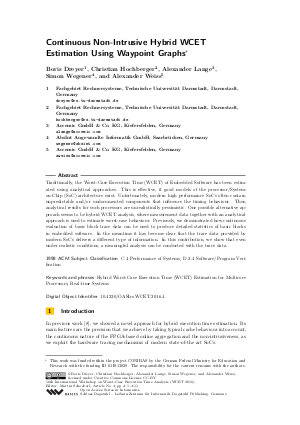Continuous Non-Intrusive Hybrid WCET Estimation Using Waypoint Graphs
Authors Boris Dreyer, Christian Hochberger, Alexander Lange, Simon Wegener, Alexander Weiss
-
Part of:
Volume:
16th International Workshop on Worst-Case Execution Time Analysis (WCET 2016)
Part of: Series: Open Access Series in Informatics (OASIcs)
Part of: Conference: Workshop on Worst-Case Execution Time Analysis (WCET) - License:
 Creative Commons Attribution 3.0 Unported license
Creative Commons Attribution 3.0 Unported license
- Publication Date: 2016-12-20
File

PDF
OASIcs.WCET.2016.4.pdf
- Filesize: 0.64 MB
- 11 pages
Document Identifiers
Subject Classification
Keywords
- Hybrid Worst-Case Execution Time (WCET) Estimation for Multicore Processors
- Real-time Systems
Metrics
- Access Statistics
-
Total Accesses (updated on a weekly basis)
0Document
0Metadata
Abstract
Traditionally, the Worst-Case Execution Time (WCET) of Embedded Software has been estimated using analytical approaches. This is effective, if good models of the processor/System-on-Chip (SoC) architecture exist. Unfortunately, modern high performance SoCs often contain unpredictable and/or undocumented components that influence the timing behaviour. Thus, analytical results for such processors are unrealistically pessimistic. One possible alternative approach seems to be hybrid WCET analysis, where measurement data together with an analytical approach is used to estimate worst-case behaviour. Previously, we demonstrated how continuous evaluation of basic block trace data can be used to produce detailed statistics of basic blocks in embedded software. In the meantime it has become clear that the trace data provided by modern SoCs delivers a different type of information. In this contribution, we show that even under realistic conditions, a meaningful analysis can be conducted with the trace data.
Cite As Get BibTex
Boris Dreyer, Christian Hochberger, Alexander Lange, Simon Wegener, and Alexander Weiss. Continuous Non-Intrusive Hybrid WCET Estimation Using Waypoint Graphs. In 16th International Workshop on Worst-Case Execution Time Analysis (WCET 2016). Open Access Series in Informatics (OASIcs), Volume 55, pp. 4:1-4:11, Schloss Dagstuhl – Leibniz-Zentrum für Informatik (2016)
https://doi.org/10.4230/OASIcs.WCET.2016.4
BibTex
@InProceedings{dreyer_et_al:OASIcs.WCET.2016.4,
author = {Dreyer, Boris and Hochberger, Christian and Lange, Alexander and Wegener, Simon and Weiss, Alexander},
title = {{Continuous Non-Intrusive Hybrid WCET Estimation Using Waypoint Graphs}},
booktitle = {16th International Workshop on Worst-Case Execution Time Analysis (WCET 2016)},
pages = {4:1--4:11},
series = {Open Access Series in Informatics (OASIcs)},
ISBN = {978-3-95977-025-5},
ISSN = {2190-6807},
year = {2016},
volume = {55},
editor = {Schoeberl, Martin},
publisher = {Schloss Dagstuhl -- Leibniz-Zentrum f{\"u}r Informatik},
address = {Dagstuhl, Germany},
URL = {https://drops.dagstuhl.de/entities/document/10.4230/OASIcs.WCET.2016.4},
URN = {urn:nbn:de:0030-drops-68977},
doi = {10.4230/OASIcs.WCET.2016.4},
annote = {Keywords: Hybrid Worst-Case Execution Time (WCET) Estimation for Multicore Processors, Real-time Systems}
}
Author Details
References
- AbsInt Angewandte Informatik GmbH. aiT Worst-Case Execution Time Analyzer. URL: http://www.absint.com/ait/.
-
ARM Ltd. CoreSight™ Program Flow Trace™ PFTv1.0 and PFTv1.1 Architecture Specification, 2011. ARM IHI 0035B.

-
ARM Ltd. Embedded Trace Macrocell™ ETMv1.0 to ETMv3.5, 2011. ARM IHI 0014Q.

-
ARM Ltd. CoreSight™ Architecture Specification v2.0, 2013. ARM IHI 0029B.

-
ARM Ltd. Embedded Trace Macrocell™ Architecture Specification ETMv4.0 to ETMv4.2, 2016. ARM IHI 0064D.

- A. Betts and G. Bernat. Tree-based wcet analysis on instrumentation point graphs. In 9th IEEE International Symposium on Object and Component-Oriented Real-Time Distributed Computing (ISORC 2006). IEEE Computer Society, April 2006. URL: http://dx.doi.org/10.1109/ISORC.2006.75.
- A. Betts, N. Merriam, and G. Bernat. Hybrid measurement-based WCET analysis at the source level using object-level traces. In B. Lisper, editor, 10th International Workshop on Worst-Case Execution Time Analysis (WCET 2010), volume 15 of OpenAccess Series in Informatics (OASIcs), pages 54-63. Schloss Dagstuhl-Leibniz-Zentrum fuer Informatik, 2010. URL: http://dx.doi.org/10.4230/OASIcs.WCET.2010.54.
- B. Dreyer, C. Hochberger, S. Wegener, and A. Weiss. Precise Continuous Non-Intrusive Measurement-Based Execution Time Estimation. In Francisco J. Cazorla, editor, 15th International Workshop on Worst-Case Execution Time Analysis (WCET 2015), volume 47 of OpenAccess Series in Informatics (OASIcs), pages 45-54, Dagstuhl, Germany, 2015. Schloss Dagstuhl-Leibniz-Zentrum fuer Informatik. URL: http://dx.doi.org/10.4230/OASIcs.WCET.2015.45.
-
H. Falk, S. Altmeyer, P. Hellinckx, B. Lisper, W. Puffitsch, C. Rochange, M. Schoeberl, R. B. Sørensen, P. Wägemann, and S. Wegener. TACLeBench: A Benchmark Collection to Support Worst-Case Execution Time Research. In Martin Schoeberl, editor, 16th International Workshop on Worst-Case Execution Time Analysis (WCET 2016), volume 55 of OpenAccess Series in Informatics (OASIcs), pages 2:1-2:10, Dagstuhl, Germany, 2016. Schloss Dagstuhl-Leibniz-Zentrum fuer Informatik.

-
Freescale Semiconductor, Inc. P4080 Advanced QorIQ Debug and Performance Monitoring Reference Manual, Rev. F, 2012.

-
IEEE-ISTO. IEEE-ISTO 5001™-2012, The Nexus 5001™ Forum Standard for a Global Embedded Processor Debug Interface, 2012.

- K. Schmidt, D. Marx, J. Harnisch, and A. Mayer. Non-Intrusive Tracing at First Instruction. SAE Technical Paper 2015-01-0176. URL: http://dx.doi.org/10.4271/2015-01-0176.
- S. Stattelmann and F. Martin. On the Use of Context Information for Precise Measurement-Based Execution Time Estimation. In B. Lisper, editor, 10th International Workshop on Worst-Case Execution Time Analysis (WCET 2010), volume 15 of OpenAccess Series in Informatics (OASIcs), pages 64-76. Schloss Dagstuhl-Leibniz-Zentrum fuer Informatik, 2010. URL: http://dx.doi.org/10.4230/OASIcs.WCET.2010.64.
-
R. Wilhelm, J. Engblom, A. Ermedahl, N. Holsti, S. Thesing, D. Whalley, G. Bernat, C. Ferdinand, R. Heckmann, F. Mueller, I. Puaut, P. Puschner, J. Staschulat, and P. Stenström. The Determination of Worst-Case Execution Times - Overview of the Methods and Survey of Tools. ACM Transactions on Embedded Computing Systems (TECS), 7(3), 2008.

